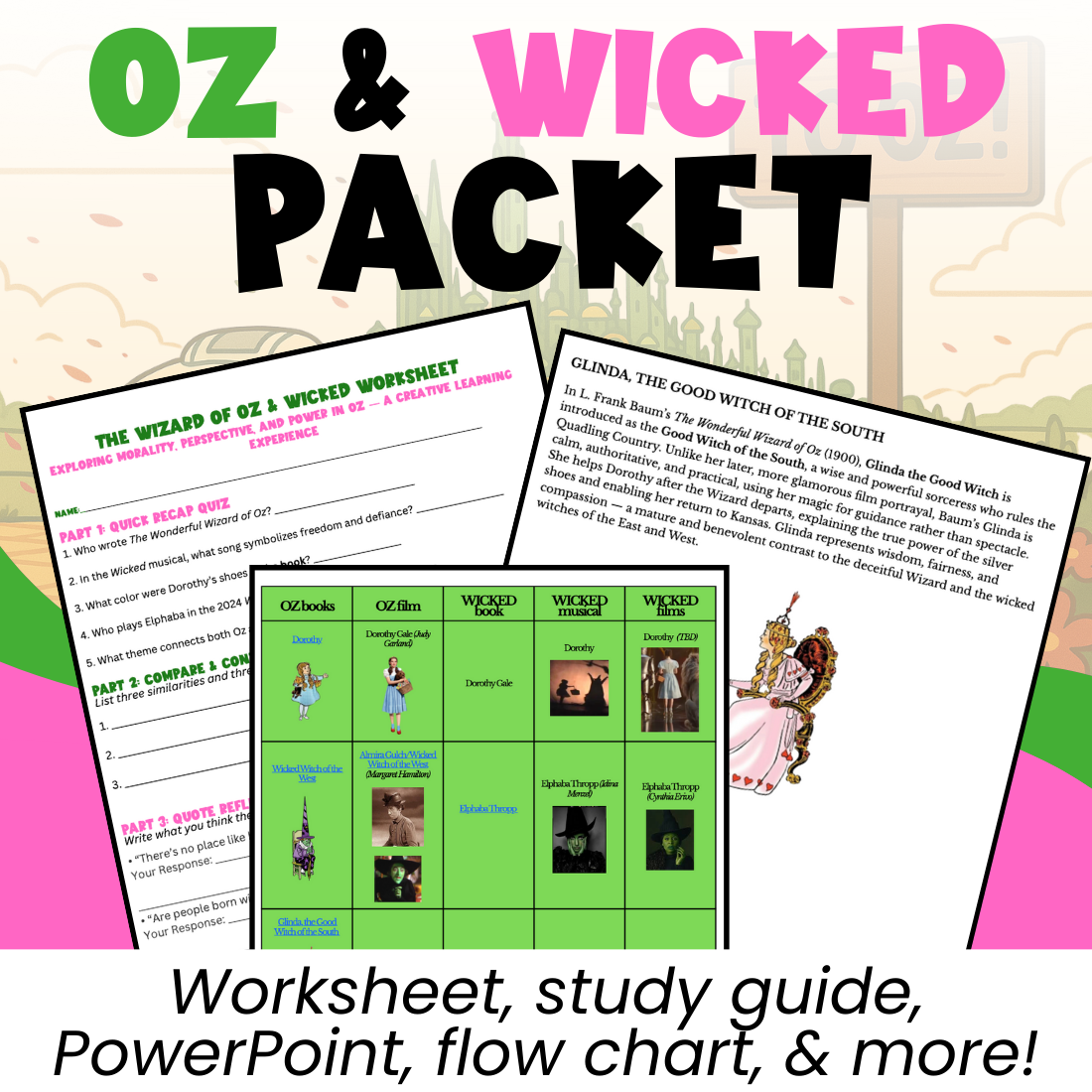 Image 1 of 1
Image 1 of 1


Wicked & Oz Packet
Focus:
Analyzing character development, morality, and perspective across The Wizard of Oz and Wicked through literature, film, and musical theatre.
Grades:
Grades 5–9
Concepts:
Character Traits, Moral Perspective, Comparative Analysis, Themes, Symbolism, Adaptation, Narrative Voice, Identity, Perception vs. Reality
Classroom Applications:
Students explore how characters like Dorothy, Elphaba, Glinda, and the Wizard evolve across books, films, and musicals. Using the Oz Character Chart (pages 1–4) and character analyses (pages 5–32), students compare portrayals across mediums.
Activities include comparing themes from the Comparative Study Guide—such as identity, power, and morality—and completing structured worksheets with quote reflections, theme analysis, and creative extensions like designing an Oz-inspired character or writing crossover scenes (Worksheet pp. 1–2).
Students study how adaptations reinterpret “good” and “wicked,” how medium affects tone (film vs. novel vs. stage), and how themes shift from innocence (Oz) to political allegory (Wicked).
Standards Alignment:
CCSS.ELA-LITERACY.RL.7.3 – Analyze how particular elements of a story interact (e.g., character vs. setting, character transformation across texts).
CCSS.ELA-LITERACY.RL.6.9 – Compare and contrast texts in different forms or genres.
CCSS.ELA-LITERACY.RI.7.6 – Determine an author’s point of view and how it is conveyed.
CCSS.ELA-LITERACY.W.7.1 – Write arguments to support claims with clear reasons and relevant evidence.
CCSS.ELA-LITERACY.RL.6.2 – Determine central themes and how they are developed.
Learning Outcomes:
Students will:
Compare characters across multiple Oz universes and analyze how adaptations shift meaning.
Explain how Wicked reframes villains as misunderstood protagonists through perspective (Elphaba, Nessarose, the Wizard).
Identify themes such as power, corruption, identity, and perception using evidence from text and visuals.
Interpret significant quotes (“There’s no place like home,” “Are people born wicked…”) to understand deeper moral messages.
Strengthen critical thinking using worksheets, character charts, and thematic questions.
Create original interpretations by designing characters or writing scenes that blend Oz and Wicked perspectives.
Focus:
Analyzing character development, morality, and perspective across The Wizard of Oz and Wicked through literature, film, and musical theatre.
Grades:
Grades 5–9
Concepts:
Character Traits, Moral Perspective, Comparative Analysis, Themes, Symbolism, Adaptation, Narrative Voice, Identity, Perception vs. Reality
Classroom Applications:
Students explore how characters like Dorothy, Elphaba, Glinda, and the Wizard evolve across books, films, and musicals. Using the Oz Character Chart (pages 1–4) and character analyses (pages 5–32), students compare portrayals across mediums.
Activities include comparing themes from the Comparative Study Guide—such as identity, power, and morality—and completing structured worksheets with quote reflections, theme analysis, and creative extensions like designing an Oz-inspired character or writing crossover scenes (Worksheet pp. 1–2).
Students study how adaptations reinterpret “good” and “wicked,” how medium affects tone (film vs. novel vs. stage), and how themes shift from innocence (Oz) to political allegory (Wicked).
Standards Alignment:
CCSS.ELA-LITERACY.RL.7.3 – Analyze how particular elements of a story interact (e.g., character vs. setting, character transformation across texts).
CCSS.ELA-LITERACY.RL.6.9 – Compare and contrast texts in different forms or genres.
CCSS.ELA-LITERACY.RI.7.6 – Determine an author’s point of view and how it is conveyed.
CCSS.ELA-LITERACY.W.7.1 – Write arguments to support claims with clear reasons and relevant evidence.
CCSS.ELA-LITERACY.RL.6.2 – Determine central themes and how they are developed.
Learning Outcomes:
Students will:
Compare characters across multiple Oz universes and analyze how adaptations shift meaning.
Explain how Wicked reframes villains as misunderstood protagonists through perspective (Elphaba, Nessarose, the Wizard).
Identify themes such as power, corruption, identity, and perception using evidence from text and visuals.
Interpret significant quotes (“There’s no place like home,” “Are people born wicked…”) to understand deeper moral messages.
Strengthen critical thinking using worksheets, character charts, and thematic questions.
Create original interpretations by designing characters or writing scenes that blend Oz and Wicked perspectives.
